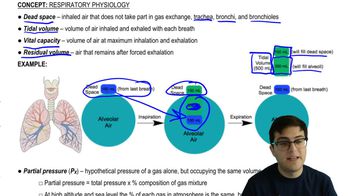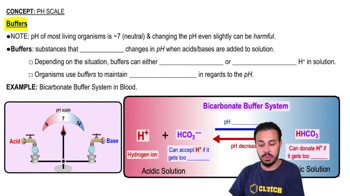Table of contents
- 1. Introduction to Biology2h 42m
- 2. Chemistry3h 40m
- 3. Water1h 26m
- 4. Biomolecules2h 23m
- 5. Cell Components2h 26m
- 6. The Membrane2h 31m
- 7. Energy and Metabolism2h 0m
- 8. Respiration2h 40m
- 9. Photosynthesis2h 49m
- 10. Cell Signaling59m
- 11. Cell Division2h 47m
- 12. Meiosis2h 0m
- 13. Mendelian Genetics4h 44m
- Introduction to Mendel's Experiments7m
- Genotype vs. Phenotype17m
- Punnett Squares13m
- Mendel's Experiments26m
- Mendel's Laws18m
- Monohybrid Crosses19m
- Test Crosses14m
- Dihybrid Crosses20m
- Punnett Square Probability26m
- Incomplete Dominance vs. Codominance20m
- Epistasis7m
- Non-Mendelian Genetics12m
- Pedigrees6m
- Autosomal Inheritance21m
- Sex-Linked Inheritance43m
- X-Inactivation9m
- 14. DNA Synthesis2h 27m
- 15. Gene Expression3h 20m
- 16. Regulation of Expression3h 31m
- Introduction to Regulation of Gene Expression13m
- Prokaryotic Gene Regulation via Operons27m
- The Lac Operon21m
- Glucose's Impact on Lac Operon25m
- The Trp Operon20m
- Review of the Lac Operon & Trp Operon11m
- Introduction to Eukaryotic Gene Regulation9m
- Eukaryotic Chromatin Modifications16m
- Eukaryotic Transcriptional Control22m
- Eukaryotic Post-Transcriptional Regulation28m
- Eukaryotic Post-Translational Regulation13m
- 17. Viruses37m
- 18. Biotechnology2h 58m
- 19. Genomics17m
- 20. Development1h 5m
- 21. Evolution3h 1m
- 22. Evolution of Populations3h 52m
- 23. Speciation1h 37m
- 24. History of Life on Earth2h 6m
- 25. Phylogeny2h 31m
- 26. Prokaryotes4h 59m
- 27. Protists1h 12m
- 28. Plants1h 22m
- 29. Fungi36m
- 30. Overview of Animals34m
- 31. Invertebrates1h 2m
- 32. Vertebrates50m
- 33. Plant Anatomy1h 3m
- 34. Vascular Plant Transport1h 2m
- 35. Soil37m
- 36. Plant Reproduction47m
- 37. Plant Sensation and Response1h 9m
- 38. Animal Form and Function1h 19m
- 39. Digestive System1h 10m
- 40. Circulatory System1h 57m
- 41. Immune System1h 12m
- 42. Osmoregulation and Excretion50m
- 43. Endocrine System1h 4m
- 44. Animal Reproduction1h 2m
- 45. Nervous System1h 55m
- 46. Sensory Systems46m
- 47. Muscle Systems23m
- 48. Ecology3h 11m
- Introduction to Ecology20m
- Biogeography14m
- Earth's Climate Patterns50m
- Introduction to Terrestrial Biomes10m
- Terrestrial Biomes: Near Equator13m
- Terrestrial Biomes: Temperate Regions10m
- Terrestrial Biomes: Northern Regions15m
- Introduction to Aquatic Biomes27m
- Freshwater Aquatic Biomes14m
- Marine Aquatic Biomes13m
- 49. Animal Behavior28m
- 50. Population Ecology3h 41m
- Introduction to Population Ecology28m
- Population Sampling Methods23m
- Life History12m
- Population Demography17m
- Factors Limiting Population Growth14m
- Introduction to Population Growth Models22m
- Linear Population Growth6m
- Exponential Population Growth29m
- Logistic Population Growth32m
- r/K Selection10m
- The Human Population22m
- 51. Community Ecology2h 46m
- Introduction to Community Ecology2m
- Introduction to Community Interactions9m
- Community Interactions: Competition (-/-)38m
- Community Interactions: Exploitation (+/-)23m
- Community Interactions: Mutualism (+/+) & Commensalism (+/0)9m
- Community Structure35m
- Community Dynamics26m
- Geographic Impact on Communities21m
- 52. Ecosystems2h 36m
- 53. Conservation Biology24m
40. Circulatory System
Gas Exchange
Problem 7`
Textbook Question
Compared with the interstitial fluid that bathes active muscle cells, blood reaching these cells in arterioles has a
a. Higher PO2.
b. Higher PCO2.
c. Greater bicarbonate concentration.
d. Lower pH.
 Verified step by step guidance
Verified step by step guidance1
Understand the role of arterioles: Arterioles are small blood vessels that branch out from arteries and lead to capillaries. They play a crucial role in delivering oxygenated blood to tissues, including muscle cells.
Consider the composition of blood in arterioles: Blood in arterioles is typically rich in oxygen because it is coming directly from the heart and lungs, where gas exchange occurs. Therefore, it has a higher partial pressure of oxygen (PO2) compared to interstitial fluid.
Analyze the interstitial fluid: Interstitial fluid is the fluid that surrounds cells in tissues. In active muscle cells, this fluid will have a different composition due to cellular respiration, which consumes oxygen and produces carbon dioxide.
Compare PO2 levels: Since blood in arterioles is oxygen-rich, it will have a higher PO2 compared to the interstitial fluid surrounding active muscle cells, where oxygen is being used up for energy production.
Evaluate other options: Consider the other choices (higher PCO2, greater bicarbonate concentration, lower pH) and understand that these are typically characteristics of the interstitial fluid due to the metabolic activity of muscle cells, which produce CO2 and may lower pH.
 Verified video answer for a similar problem:
Verified video answer for a similar problem:This video solution was recommended by our tutors as helpful for the problem above
Video duration:
2mPlay a video:
Was this helpful?
Key Concepts
Here are the essential concepts you must grasp in order to answer the question correctly.
Partial Pressure of Oxygen (PO2)
Partial pressure of oxygen (PO2) refers to the pressure exerted by oxygen in a mixture of gases or in a liquid, such as blood. In the context of blood reaching active muscle cells, the PO2 is typically higher in the arterioles compared to the interstitial fluid because blood delivers oxygen to tissues, which is then used for cellular respiration.
Recommended video:
Guided course

Air Movement and Partial Pressure
Partial Pressure of Carbon Dioxide (PCO2)
Partial pressure of carbon dioxide (PCO2) is the pressure exerted by CO2 in a mixture of gases or in a liquid. In active muscle cells, CO2 is produced as a byproduct of metabolism, leading to higher PCO2 in the interstitial fluid compared to the blood in arterioles, which is responsible for transporting CO2 away from tissues to be exhaled.
Recommended video:
Guided course

Air Movement and Partial Pressure
Bicarbonate Buffer System
The bicarbonate buffer system helps maintain pH balance in the blood. It involves the equilibrium between carbonic acid and bicarbonate ions. In active tissues, CO2 is converted to bicarbonate, increasing its concentration in the blood. This system is crucial for transporting CO2 and regulating blood pH, which tends to be lower in active tissues due to increased CO2 production.
Recommended video:
Guided course

Buffers

 5:55m
5:55mWatch next
Master Gas Exchange and Breathing with a bite sized video explanation from Jason
Start learningRelated Videos
Related Practice




















